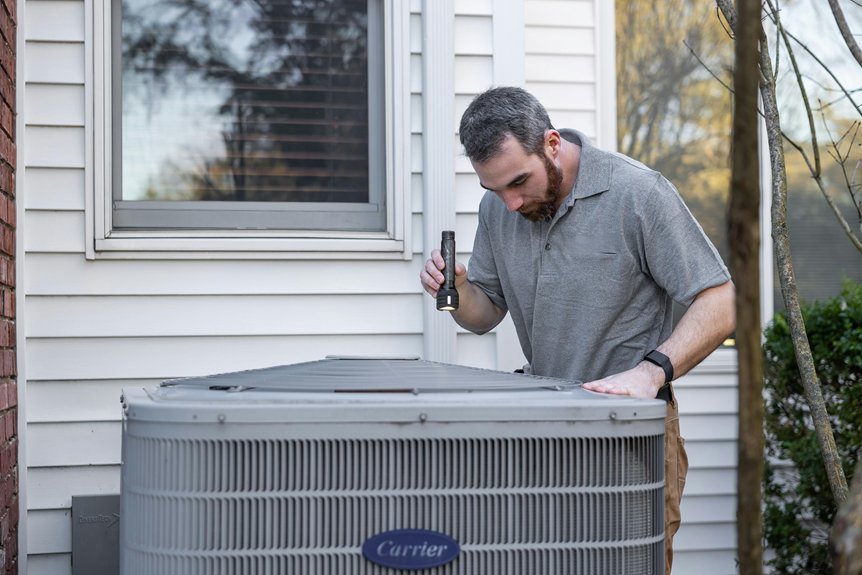Advancements in heating and air conditioning are increasingly centred around smarter, more efficient systems. IoT technology allows for remote control and monitoring, while intelligent thermostats enhance comfort and conserve energy. There is a noticeable shift towards environmentally friendly solutions, such as low-GWP refrigerants and heat pumps, driven by ecological concerns and regulatory measures.
The demand for skilled technicians to install and maintain these innovations continues to rise, yet the industry is grappling with workforce shortages. These advancements not only provide benefits for consumers, such as improved comfort and reduced energy bills, but also contribute positively to the environment.
As the landscape of heating and air conditioning evolves, staying informed about the latest trends and technologies is essential for both consumers and industry professionals.
Trends Driving HVAC Innovation
Recent trends are transforming the HVAC industry in the UK, with a strong emphasis on innovations that enhance energy efficiency, convenience, and sustainability.
The integration of IoT technology enables systems to be monitored and controlled remotely, facilitating regular adjustments and maintenance for optimal performance.
Smart thermostats and sensors play a crucial role in this evolution by collecting data on temperature, humidity, and system performance. This information helps optimise comfort while reducing energy consumption significantly.
Platforms such as Sensgreen utilise advanced devices to manage radiators, air conditioners, and plugs in commercial buildings from a distance, enhancing operational efficiency.
Moreover, the capability for over-the-air updates ensures that systems remain current and function more effectively without the need for on-site visits.
Electrification is gaining traction, with heat pumps increasingly replacing traditional systems, leading to greater efficiency and alignment with climate objectives.
The global push for renewable energy sources further supports these innovations, prompting the adoption of sustainable solutions. These advancements make modern HVAC systems not only easier to use but also more reliable and environmentally friendly, marking a significant shift towards smarter and more sustainable living solutions in the UK.
Growing Demand for Sustainable Solutions
The increasing demand for sustainable HVAC solutions in the UK stems from heightened awareness of environmental issues and more stringent government regulations. The ban on refrigerants with high Global Warming Potential (GWP) encourages manufacturers to embrace eco-friendly alternatives, such as those offered by Daikin.
Globally, regulations are promoting the adoption of low-impact coolants to meet climate objectives, bolstered by incentives and rebates that enhance the accessibility of greener options. The transition towards renewable energy sources, including solar and wind, is enabling a greater number of HVAC systems to operate with reduced dependence on fossil fuels.
Innovations in heat pump technology and electrification, alongside intelligent systems that utilise artificial intelligence and sensors, are optimising energy consumption and enhancing efficiency. These developments signify a concerted effort to create HVAC systems that are cleaner, more intelligent, and closely aligned with sustainability goals.
As the market continues to evolve, consumers are increasingly seeking solutions that not only meet their heating and cooling needs but also contribute positively to the environment. Market trends This shift underscores the importance of integrating sustainable practices within the HVAC sector, paving the way for a greener future.
Skills and Workforce Development Challenges
A significant challenge facing the HVAC industry in the UK today is the shortage of skilled technicians, which threatens the ability to meet the growing demand for heating and cooling services.
The industry is experiencing a notable number of annual job openings, yet many positions remain unfilled due to a labour gap. This shortage is exacerbated as experienced workers retire, coupled with a decline in interest among younger individuals in pursuing trades.
Limited training programmes and apprenticeship opportunities further slow the development of new talent. Investing in training and forming partnerships with trade schools can enhance retention and address these gaps.
Industry initiatives such as in-house academies and paid apprenticeships allow students to acquire essential skills and hands-on experience.
As technology advances, ongoing education becomes increasingly vital, ensuring that technicians remain current with complex systems and safety practices. The growing demand for high-performance HVAC systems in regions like the Northeast underscores the urgent need for a well-trained workforce.
Enhancing Customer Experience With Technology
How can technology enhance the customer experience in the HVAC industry? Smart HVAC systems empower users to effortlessly control and personalise their comfort. Remote monitoring through mobile applications enables homeowners and managers to adjust settings anytime, anywhere. Artificial Intelligence learns user preferences to optimise energy consumption without compromising comfort. Fault detection sensors identify issues early, minimising downtime and enhancing reliability. By integrating weather forecasts and energy grids, these systems proactively adjust for maximum efficiency. Additionally, studies show that incorporating advanced technology can significantly improve customer satisfaction and loyalty.
| Feature | Benefit |
|---|---|
| Mobile Applications and Chatbots | Instant support and improved communication |
| Predictive Maintenance | Reduced unexpected breakdowns |
| Virtual Consultations | Convenient, remote service options |
| Real-time Updates | Enhanced trust and transparency |
With these advancements, the HVAC industry is well-positioned to deliver a superior customer experience, ensuring comfort and efficiency in every home and business.
Conclusion
The HVAC industry is undergoing significant evolution, driven by emerging trends such as sustainable solutions and advanced technology designed to enhance efficiency and customer satisfaction. A key challenge remains in workforce development, but continuous training will bolster growth within the sector.
As technology increasingly enriches user experiences, companies that adapt promptly will maintain their competitive edge.
Overall, these developments indicate a more sustainable and innovative future for heating and cooling systems, benefitting both consumers and the environment.

